Diversity Policy in a Workplace: Advantages and Disadvantages
VerifiedAdded on 2020/04/01
|8
|1805
|41
Report
AI Summary
This report provides a comprehensive analysis of diversity policies in the workplace. It begins by outlining the advantages of diversity, such as fostering a diverse experience, promoting learning and growth, increasing adaptability, boosting productivity, and expanding the range of services offered. The report also acknowledges the disadvantages, including language barriers, reduced freedom of speech, and increased training costs. The report then presents findings and recommendations, emphasizing the importance of implementing diversity policies to enhance productivity and achieve organizational objectives. It suggests that organizations should train employees on how to interact with each other and avoid unnecessary competition to mitigate the disadvantages. The report concludes by recommending the adoption of diversity policies as a key strategy for achieving organizational success. The report includes references from various academic sources to support its findings and recommendations.
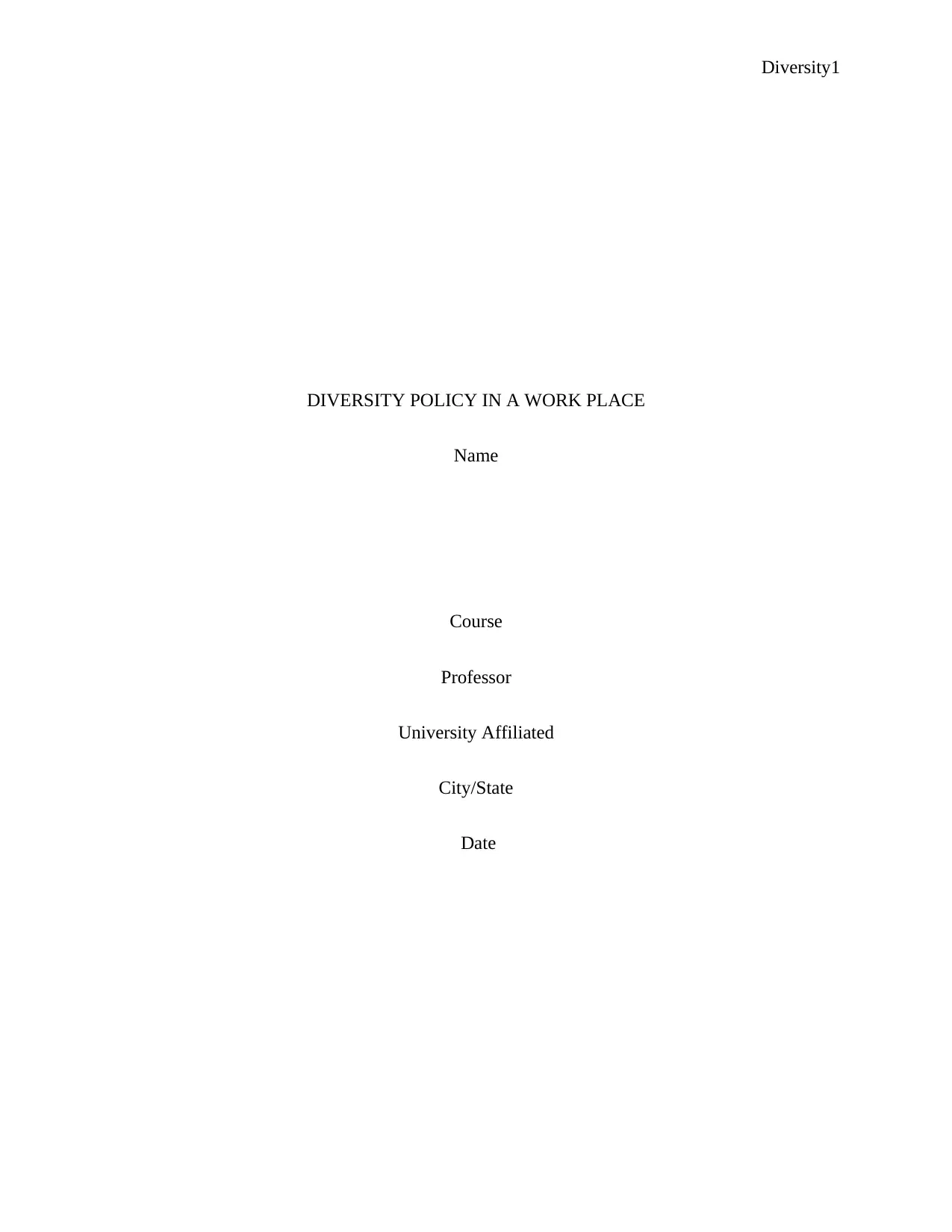
Diversity1
DIVERSITY POLICY IN A WORK PLACE
Name
Course
Professor
University Affiliated
City/State
Date
DIVERSITY POLICY IN A WORK PLACE
Name
Course
Professor
University Affiliated
City/State
Date
Paraphrase This Document
Need a fresh take? Get an instant paraphrase of this document with our AI Paraphraser
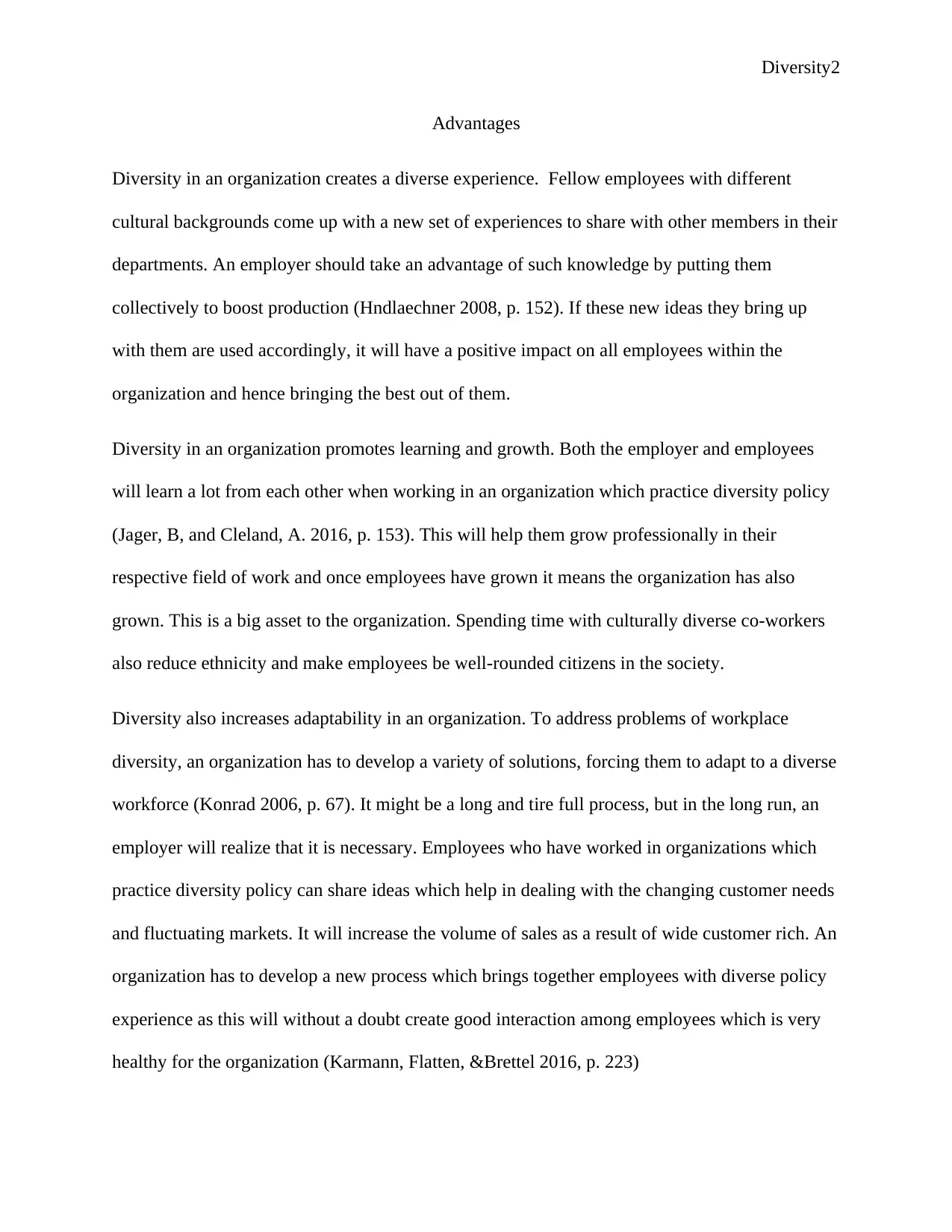
Diversity2
Advantages
Diversity in an organization creates a diverse experience. Fellow employees with different
cultural backgrounds come up with a new set of experiences to share with other members in their
departments. An employer should take an advantage of such knowledge by putting them
collectively to boost production (Hndlaechner 2008, p. 152). If these new ideas they bring up
with them are used accordingly, it will have a positive impact on all employees within the
organization and hence bringing the best out of them.
Diversity in an organization promotes learning and growth. Both the employer and employees
will learn a lot from each other when working in an organization which practice diversity policy
(Jager, B, and Cleland, A. 2016, p. 153). This will help them grow professionally in their
respective field of work and once employees have grown it means the organization has also
grown. This is a big asset to the organization. Spending time with culturally diverse co-workers
also reduce ethnicity and make employees be well-rounded citizens in the society.
Diversity also increases adaptability in an organization. To address problems of workplace
diversity, an organization has to develop a variety of solutions, forcing them to adapt to a diverse
workforce (Konrad 2006, p. 67). It might be a long and tire full process, but in the long run, an
employer will realize that it is necessary. Employees who have worked in organizations which
practice diversity policy can share ideas which help in dealing with the changing customer needs
and fluctuating markets. It will increase the volume of sales as a result of wide customer rich. An
organization has to develop a new process which brings together employees with diverse policy
experience as this will without a doubt create good interaction among employees which is very
healthy for the organization (Karmann, Flatten, &Brettel 2016, p. 223)
Advantages
Diversity in an organization creates a diverse experience. Fellow employees with different
cultural backgrounds come up with a new set of experiences to share with other members in their
departments. An employer should take an advantage of such knowledge by putting them
collectively to boost production (Hndlaechner 2008, p. 152). If these new ideas they bring up
with them are used accordingly, it will have a positive impact on all employees within the
organization and hence bringing the best out of them.
Diversity in an organization promotes learning and growth. Both the employer and employees
will learn a lot from each other when working in an organization which practice diversity policy
(Jager, B, and Cleland, A. 2016, p. 153). This will help them grow professionally in their
respective field of work and once employees have grown it means the organization has also
grown. This is a big asset to the organization. Spending time with culturally diverse co-workers
also reduce ethnicity and make employees be well-rounded citizens in the society.
Diversity also increases adaptability in an organization. To address problems of workplace
diversity, an organization has to develop a variety of solutions, forcing them to adapt to a diverse
workforce (Konrad 2006, p. 67). It might be a long and tire full process, but in the long run, an
employer will realize that it is necessary. Employees who have worked in organizations which
practice diversity policy can share ideas which help in dealing with the changing customer needs
and fluctuating markets. It will increase the volume of sales as a result of wide customer rich. An
organization has to develop a new process which brings together employees with diverse policy
experience as this will without a doubt create good interaction among employees which is very
healthy for the organization (Karmann, Flatten, &Brettel 2016, p. 223)
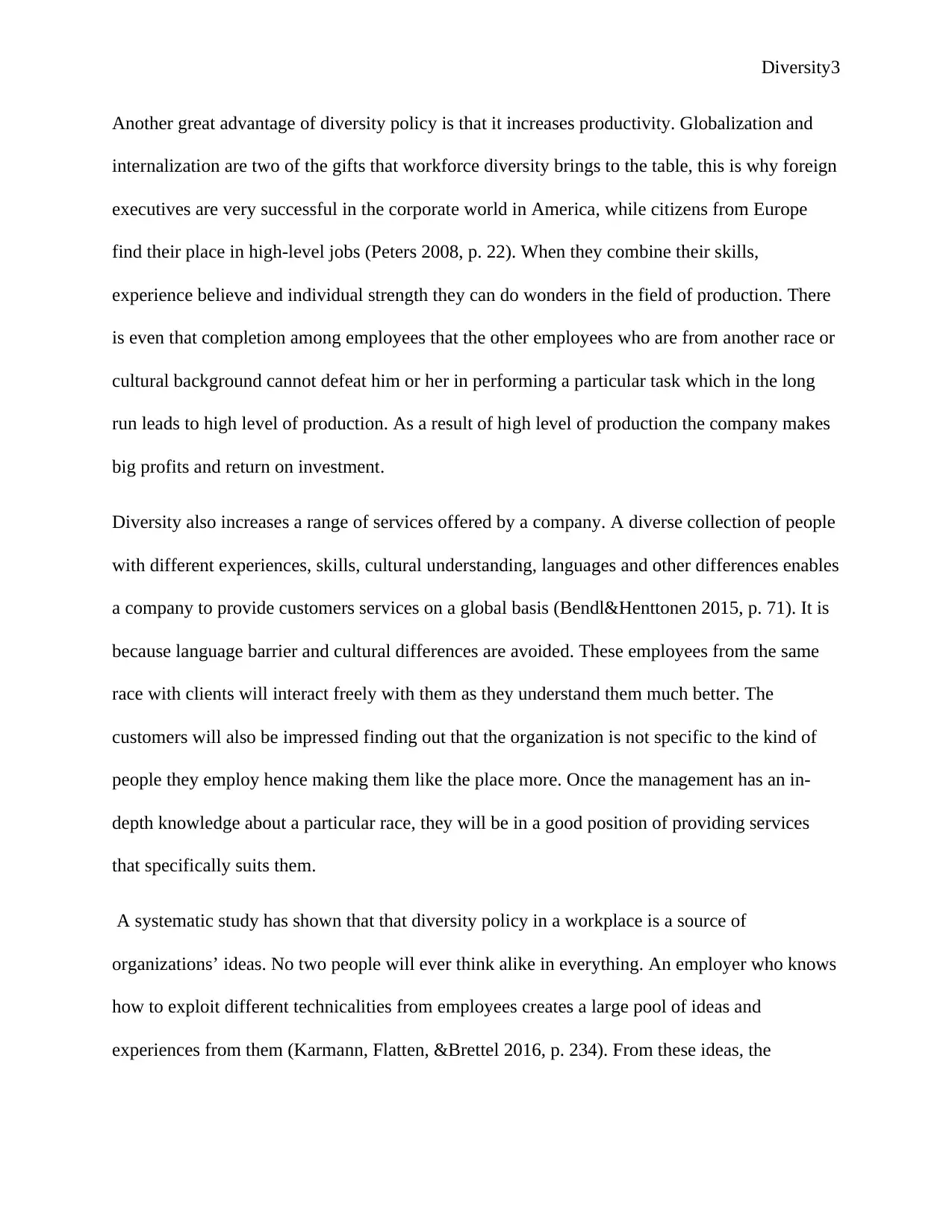
Diversity3
Another great advantage of diversity policy is that it increases productivity. Globalization and
internalization are two of the gifts that workforce diversity brings to the table, this is why foreign
executives are very successful in the corporate world in America, while citizens from Europe
find their place in high-level jobs (Peters 2008, p. 22). When they combine their skills,
experience believe and individual strength they can do wonders in the field of production. There
is even that completion among employees that the other employees who are from another race or
cultural background cannot defeat him or her in performing a particular task which in the long
run leads to high level of production. As a result of high level of production the company makes
big profits and return on investment.
Diversity also increases a range of services offered by a company. A diverse collection of people
with different experiences, skills, cultural understanding, languages and other differences enables
a company to provide customers services on a global basis (Bendl&Henttonen 2015, p. 71). It is
because language barrier and cultural differences are avoided. These employees from the same
race with clients will interact freely with them as they understand them much better. The
customers will also be impressed finding out that the organization is not specific to the kind of
people they employ hence making them like the place more. Once the management has an in-
depth knowledge about a particular race, they will be in a good position of providing services
that specifically suits them.
A systematic study has shown that that diversity policy in a workplace is a source of
organizations’ ideas. No two people will ever think alike in everything. An employer who knows
how to exploit different technicalities from employees creates a large pool of ideas and
experiences from them (Karmann, Flatten, &Brettel 2016, p. 234). From these ideas, the
Another great advantage of diversity policy is that it increases productivity. Globalization and
internalization are two of the gifts that workforce diversity brings to the table, this is why foreign
executives are very successful in the corporate world in America, while citizens from Europe
find their place in high-level jobs (Peters 2008, p. 22). When they combine their skills,
experience believe and individual strength they can do wonders in the field of production. There
is even that completion among employees that the other employees who are from another race or
cultural background cannot defeat him or her in performing a particular task which in the long
run leads to high level of production. As a result of high level of production the company makes
big profits and return on investment.
Diversity also increases a range of services offered by a company. A diverse collection of people
with different experiences, skills, cultural understanding, languages and other differences enables
a company to provide customers services on a global basis (Bendl&Henttonen 2015, p. 71). It is
because language barrier and cultural differences are avoided. These employees from the same
race with clients will interact freely with them as they understand them much better. The
customers will also be impressed finding out that the organization is not specific to the kind of
people they employ hence making them like the place more. Once the management has an in-
depth knowledge about a particular race, they will be in a good position of providing services
that specifically suits them.
A systematic study has shown that that diversity policy in a workplace is a source of
organizations’ ideas. No two people will ever think alike in everything. An employer who knows
how to exploit different technicalities from employees creates a large pool of ideas and
experiences from them (Karmann, Flatten, &Brettel 2016, p. 234). From these ideas, the
⊘ This is a preview!⊘
Do you want full access?
Subscribe today to unlock all pages.

Trusted by 1+ million students worldwide
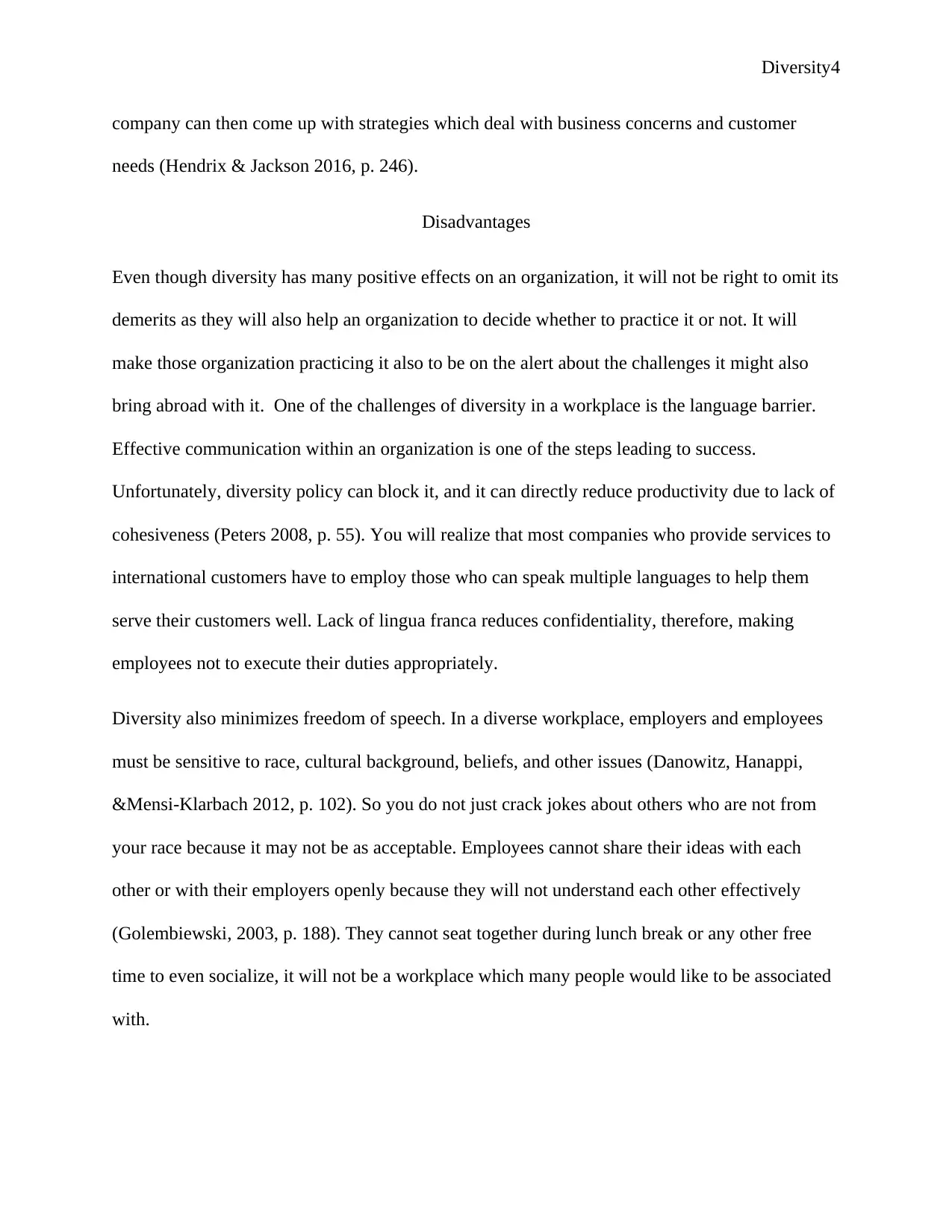
Diversity4
company can then come up with strategies which deal with business concerns and customer
needs (Hendrix & Jackson 2016, p. 246).
Disadvantages
Even though diversity has many positive effects on an organization, it will not be right to omit its
demerits as they will also help an organization to decide whether to practice it or not. It will
make those organization practicing it also to be on the alert about the challenges it might also
bring abroad with it. One of the challenges of diversity in a workplace is the language barrier.
Effective communication within an organization is one of the steps leading to success.
Unfortunately, diversity policy can block it, and it can directly reduce productivity due to lack of
cohesiveness (Peters 2008, p. 55). You will realize that most companies who provide services to
international customers have to employ those who can speak multiple languages to help them
serve their customers well. Lack of lingua franca reduces confidentiality, therefore, making
employees not to execute their duties appropriately.
Diversity also minimizes freedom of speech. In a diverse workplace, employers and employees
must be sensitive to race, cultural background, beliefs, and other issues (Danowitz, Hanappi,
&Mensi-Klarbach 2012, p. 102). So you do not just crack jokes about others who are not from
your race because it may not be as acceptable. Employees cannot share their ideas with each
other or with their employers openly because they will not understand each other effectively
(Golembiewski, 2003, p. 188). They cannot seat together during lunch break or any other free
time to even socialize, it will not be a workplace which many people would like to be associated
with.
company can then come up with strategies which deal with business concerns and customer
needs (Hendrix & Jackson 2016, p. 246).
Disadvantages
Even though diversity has many positive effects on an organization, it will not be right to omit its
demerits as they will also help an organization to decide whether to practice it or not. It will
make those organization practicing it also to be on the alert about the challenges it might also
bring abroad with it. One of the challenges of diversity in a workplace is the language barrier.
Effective communication within an organization is one of the steps leading to success.
Unfortunately, diversity policy can block it, and it can directly reduce productivity due to lack of
cohesiveness (Peters 2008, p. 55). You will realize that most companies who provide services to
international customers have to employ those who can speak multiple languages to help them
serve their customers well. Lack of lingua franca reduces confidentiality, therefore, making
employees not to execute their duties appropriately.
Diversity also minimizes freedom of speech. In a diverse workplace, employers and employees
must be sensitive to race, cultural background, beliefs, and other issues (Danowitz, Hanappi,
&Mensi-Klarbach 2012, p. 102). So you do not just crack jokes about others who are not from
your race because it may not be as acceptable. Employees cannot share their ideas with each
other or with their employers openly because they will not understand each other effectively
(Golembiewski, 2003, p. 188). They cannot seat together during lunch break or any other free
time to even socialize, it will not be a workplace which many people would like to be associated
with.
Paraphrase This Document
Need a fresh take? Get an instant paraphrase of this document with our AI Paraphraser
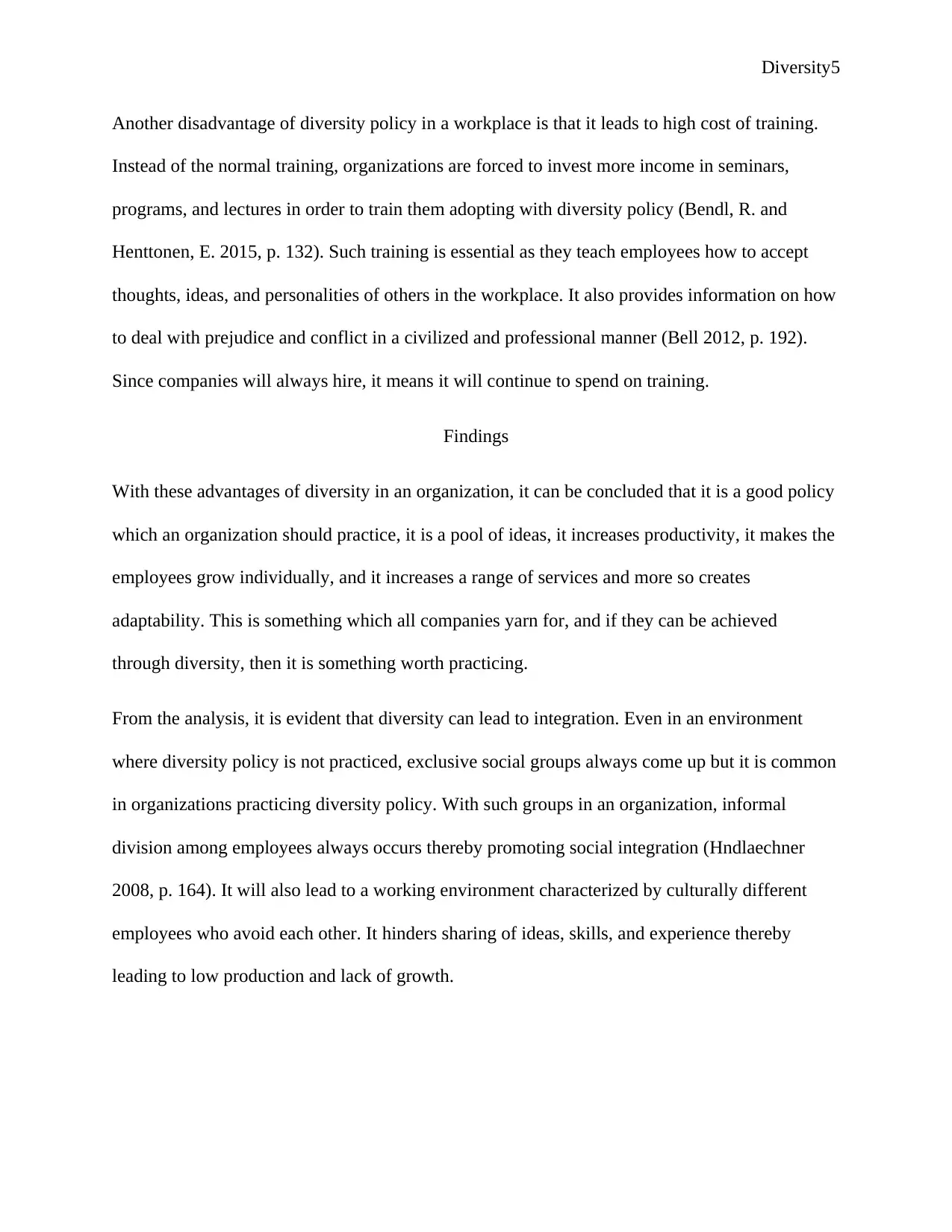
Diversity5
Another disadvantage of diversity policy in a workplace is that it leads to high cost of training.
Instead of the normal training, organizations are forced to invest more income in seminars,
programs, and lectures in order to train them adopting with diversity policy (Bendl, R. and
Henttonen, E. 2015, p. 132). Such training is essential as they teach employees how to accept
thoughts, ideas, and personalities of others in the workplace. It also provides information on how
to deal with prejudice and conflict in a civilized and professional manner (Bell 2012, p. 192).
Since companies will always hire, it means it will continue to spend on training.
Findings
With these advantages of diversity in an organization, it can be concluded that it is a good policy
which an organization should practice, it is a pool of ideas, it increases productivity, it makes the
employees grow individually, and it increases a range of services and more so creates
adaptability. This is something which all companies yarn for, and if they can be achieved
through diversity, then it is something worth practicing.
From the analysis, it is evident that diversity can lead to integration. Even in an environment
where diversity policy is not practiced, exclusive social groups always come up but it is common
in organizations practicing diversity policy. With such groups in an organization, informal
division among employees always occurs thereby promoting social integration (Hndlaechner
2008, p. 164). It will also lead to a working environment characterized by culturally different
employees who avoid each other. It hinders sharing of ideas, skills, and experience thereby
leading to low production and lack of growth.
Another disadvantage of diversity policy in a workplace is that it leads to high cost of training.
Instead of the normal training, organizations are forced to invest more income in seminars,
programs, and lectures in order to train them adopting with diversity policy (Bendl, R. and
Henttonen, E. 2015, p. 132). Such training is essential as they teach employees how to accept
thoughts, ideas, and personalities of others in the workplace. It also provides information on how
to deal with prejudice and conflict in a civilized and professional manner (Bell 2012, p. 192).
Since companies will always hire, it means it will continue to spend on training.
Findings
With these advantages of diversity in an organization, it can be concluded that it is a good policy
which an organization should practice, it is a pool of ideas, it increases productivity, it makes the
employees grow individually, and it increases a range of services and more so creates
adaptability. This is something which all companies yarn for, and if they can be achieved
through diversity, then it is something worth practicing.
From the analysis, it is evident that diversity can lead to integration. Even in an environment
where diversity policy is not practiced, exclusive social groups always come up but it is common
in organizations practicing diversity policy. With such groups in an organization, informal
division among employees always occurs thereby promoting social integration (Hndlaechner
2008, p. 164). It will also lead to a working environment characterized by culturally different
employees who avoid each other. It hinders sharing of ideas, skills, and experience thereby
leading to low production and lack of growth.
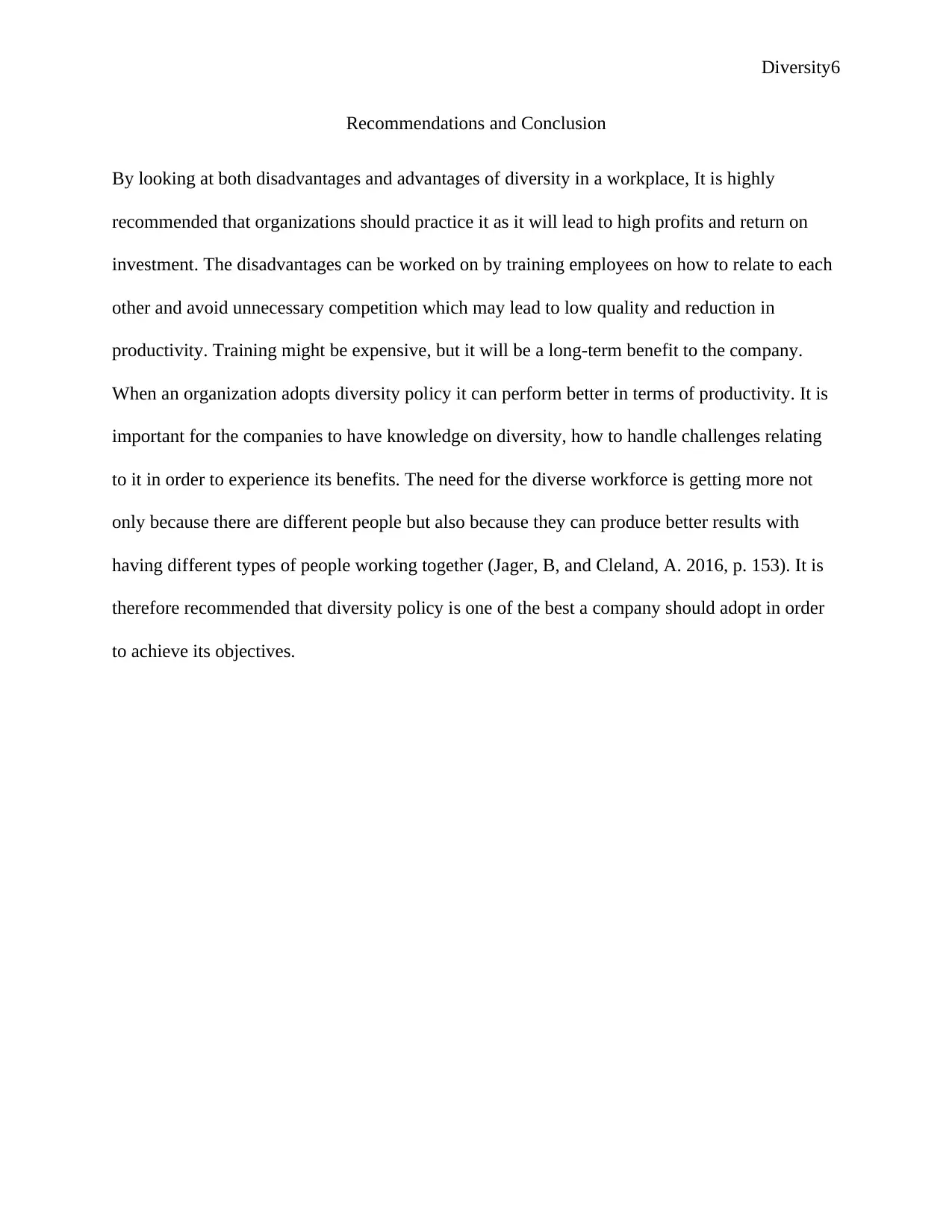
Diversity6
Recommendations and Conclusion
By looking at both disadvantages and advantages of diversity in a workplace, It is highly
recommended that organizations should practice it as it will lead to high profits and return on
investment. The disadvantages can be worked on by training employees on how to relate to each
other and avoid unnecessary competition which may lead to low quality and reduction in
productivity. Training might be expensive, but it will be a long-term benefit to the company.
When an organization adopts diversity policy it can perform better in terms of productivity. It is
important for the companies to have knowledge on diversity, how to handle challenges relating
to it in order to experience its benefits. The need for the diverse workforce is getting more not
only because there are different people but also because they can produce better results with
having different types of people working together (Jager, B, and Cleland, A. 2016, p. 153). It is
therefore recommended that diversity policy is one of the best a company should adopt in order
to achieve its objectives.
Recommendations and Conclusion
By looking at both disadvantages and advantages of diversity in a workplace, It is highly
recommended that organizations should practice it as it will lead to high profits and return on
investment. The disadvantages can be worked on by training employees on how to relate to each
other and avoid unnecessary competition which may lead to low quality and reduction in
productivity. Training might be expensive, but it will be a long-term benefit to the company.
When an organization adopts diversity policy it can perform better in terms of productivity. It is
important for the companies to have knowledge on diversity, how to handle challenges relating
to it in order to experience its benefits. The need for the diverse workforce is getting more not
only because there are different people but also because they can produce better results with
having different types of people working together (Jager, B, and Cleland, A. 2016, p. 153). It is
therefore recommended that diversity policy is one of the best a company should adopt in order
to achieve its objectives.
⊘ This is a preview!⊘
Do you want full access?
Subscribe today to unlock all pages.

Trusted by 1+ million students worldwide
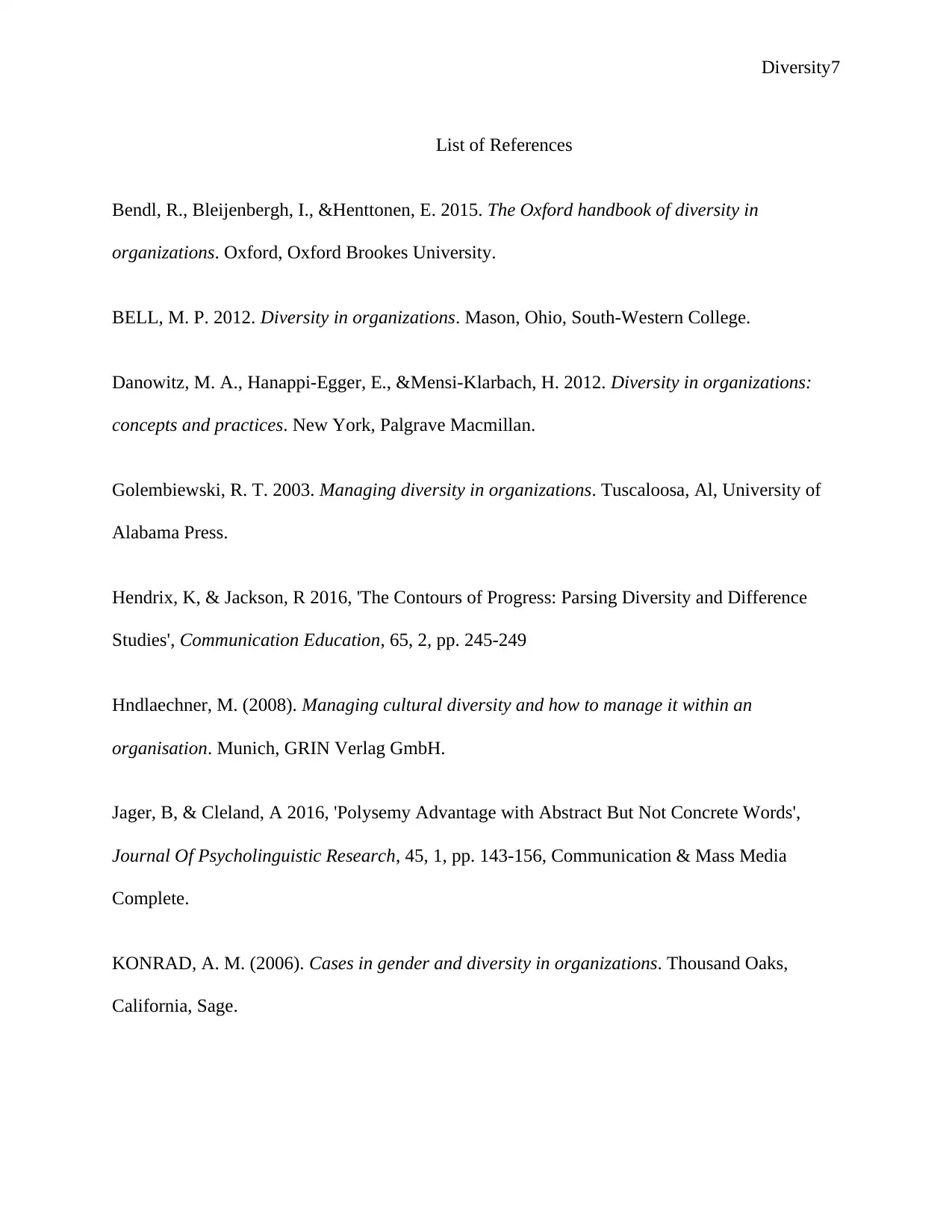
Diversity7
List of References
Bendl, R., Bleijenbergh, I., &Henttonen, E. 2015. The Oxford handbook of diversity in
organizations. Oxford, Oxford Brookes University.
BELL, M. P. 2012. Diversity in organizations. Mason, Ohio, South-Western College.
Danowitz, M. A., Hanappi-Egger, E., &Mensi-Klarbach, H. 2012. Diversity in organizations:
concepts and practices. New York, Palgrave Macmillan.
Golembiewski, R. T. 2003. Managing diversity in organizations. Tuscaloosa, Al, University of
Alabama Press.
Hendrix, K, & Jackson, R 2016, 'The Contours of Progress: Parsing Diversity and Difference
Studies', Communication Education, 65, 2, pp. 245-249
Hndlaechner, M. (2008). Managing cultural diversity and how to manage it within an
organisation. Munich, GRIN Verlag GmbH.
Jager, B, & Cleland, A 2016, 'Polysemy Advantage with Abstract But Not Concrete Words',
Journal Of Psycholinguistic Research, 45, 1, pp. 143-156, Communication & Mass Media
Complete.
KONRAD, A. M. (2006). Cases in gender and diversity in organizations. Thousand Oaks,
California, Sage.
List of References
Bendl, R., Bleijenbergh, I., &Henttonen, E. 2015. The Oxford handbook of diversity in
organizations. Oxford, Oxford Brookes University.
BELL, M. P. 2012. Diversity in organizations. Mason, Ohio, South-Western College.
Danowitz, M. A., Hanappi-Egger, E., &Mensi-Klarbach, H. 2012. Diversity in organizations:
concepts and practices. New York, Palgrave Macmillan.
Golembiewski, R. T. 2003. Managing diversity in organizations. Tuscaloosa, Al, University of
Alabama Press.
Hendrix, K, & Jackson, R 2016, 'The Contours of Progress: Parsing Diversity and Difference
Studies', Communication Education, 65, 2, pp. 245-249
Hndlaechner, M. (2008). Managing cultural diversity and how to manage it within an
organisation. Munich, GRIN Verlag GmbH.
Jager, B, & Cleland, A 2016, 'Polysemy Advantage with Abstract But Not Concrete Words',
Journal Of Psycholinguistic Research, 45, 1, pp. 143-156, Communication & Mass Media
Complete.
KONRAD, A. M. (2006). Cases in gender and diversity in organizations. Thousand Oaks,
California, Sage.
Paraphrase This Document
Need a fresh take? Get an instant paraphrase of this document with our AI Paraphraser
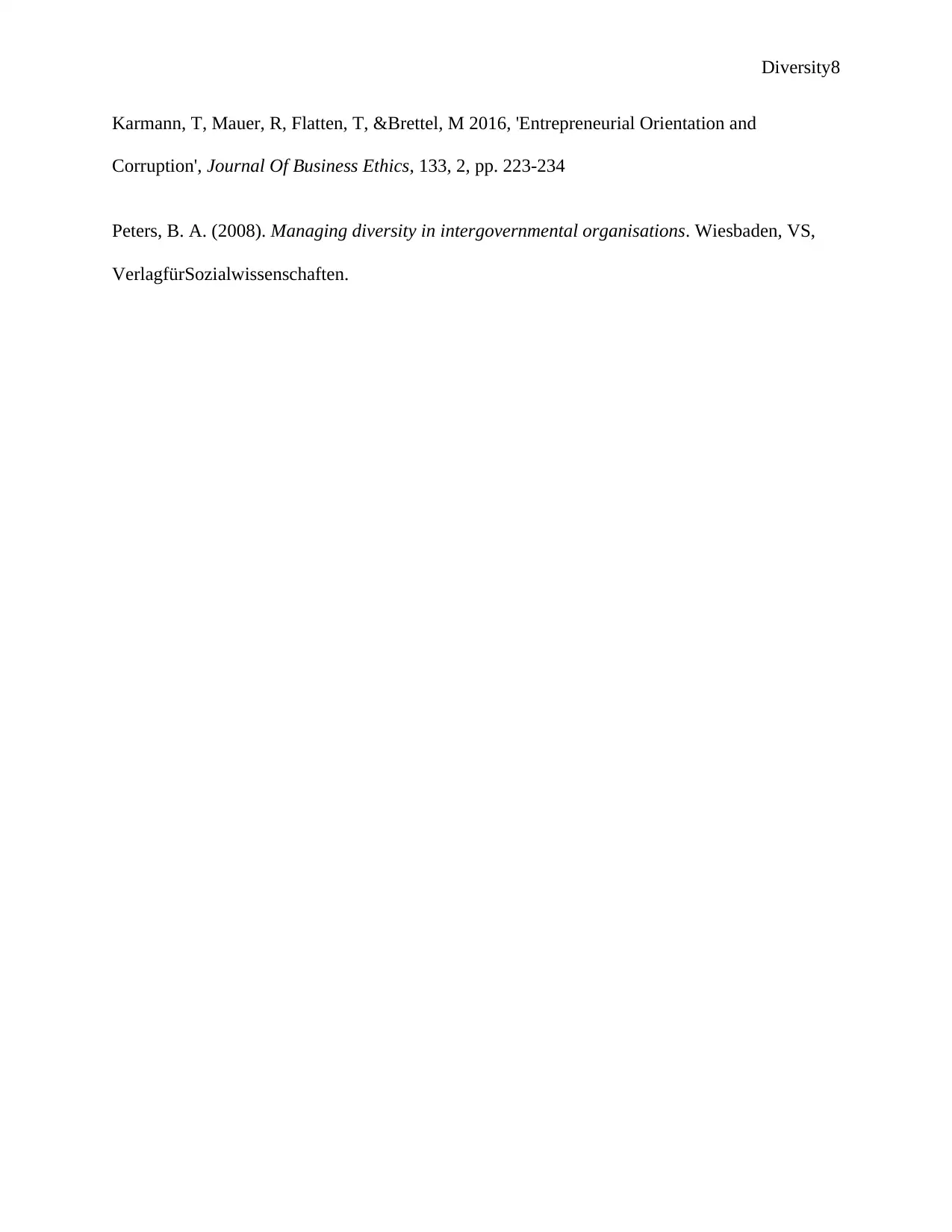
Diversity8
Karmann, T, Mauer, R, Flatten, T, &Brettel, M 2016, 'Entrepreneurial Orientation and
Corruption', Journal Of Business Ethics, 133, 2, pp. 223-234
Peters, B. A. (2008). Managing diversity in intergovernmental organisations. Wiesbaden, VS,
VerlagfürSozialwissenschaften.
Karmann, T, Mauer, R, Flatten, T, &Brettel, M 2016, 'Entrepreneurial Orientation and
Corruption', Journal Of Business Ethics, 133, 2, pp. 223-234
Peters, B. A. (2008). Managing diversity in intergovernmental organisations. Wiesbaden, VS,
VerlagfürSozialwissenschaften.
1 out of 8
Related Documents
Your All-in-One AI-Powered Toolkit for Academic Success.
+13062052269
info@desklib.com
Available 24*7 on WhatsApp / Email
![[object Object]](/_next/static/media/star-bottom.7253800d.svg)
Unlock your academic potential
Copyright © 2020–2025 A2Z Services. All Rights Reserved. Developed and managed by ZUCOL.





